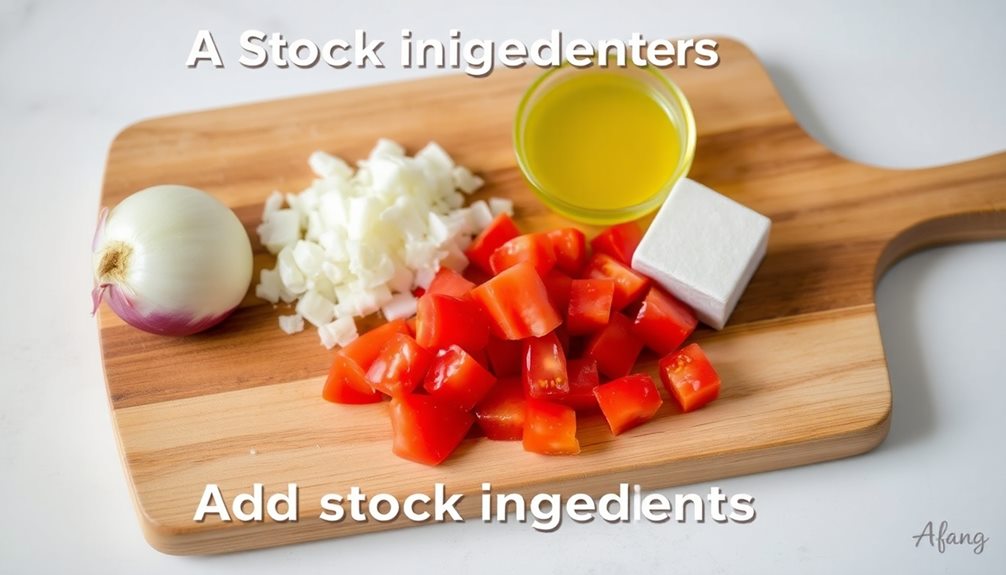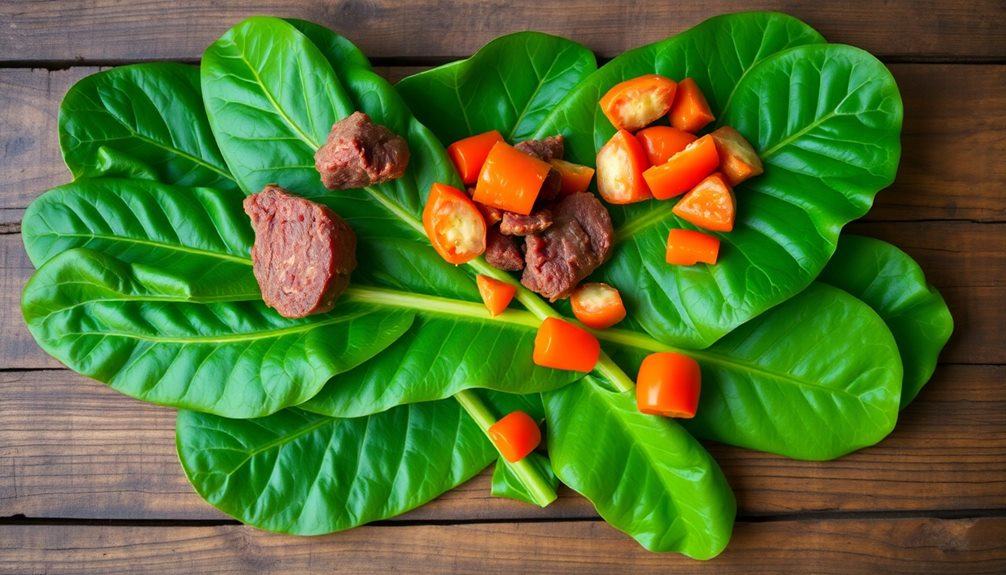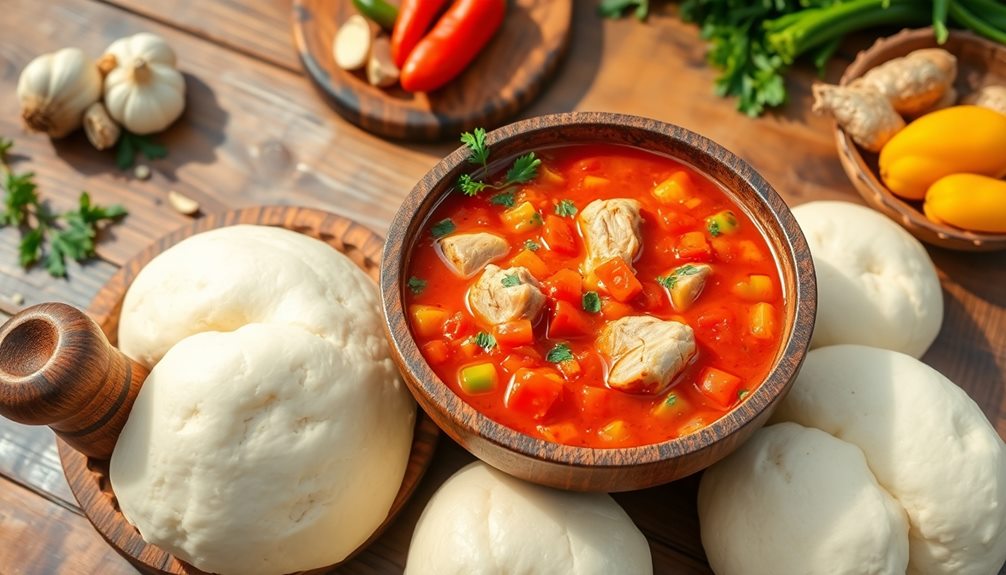Get ready to embark on a flavorful journey through the heart of Nigerian cuisine with afang soup! This robust and nutritious leaf soup originates from the Efik and Ibibio people, who've perfected its preparation over generations. The key? Tender afang leaves, simmered to perfection with a mix of meats, fish, and spices. First, you'll wash and slice the leaves, then add fragrant chicken stock and a blend of savory seasonings. Don't forget the juicy periwinkles – they lend a unique depth of flavor. As the soup simmers, the aroma will have your mouth watering. And if you keep reading, you'll uncover the secrets to crafting this beloved Nigerian dish.
Key Takeaways
- Afang soup originates from the Efik and Ibibio people of southeastern Nigeria and is considered a nutritious staple in Nigerian cuisine.
- The unique preparation method involves simmering afang leaves, meats, fish, and spices to create a flavorful and culturally significant dish.
- Proper washing and slicing of the afang leaves are crucial for enhancing the soup's flavor and texture balance.
- The addition of chicken stock, onions, and dried afang leaves creates a robust and savory base for the soup.
- Patience during the simmering process allows the flavors to meld, resulting in tender afang leaves and a satisfying dining experience.
History

Although the exact origins of afang soup are unclear, it's believed to have emerged from the culinary traditions of the Efik and Ibibio people of southeastern Nigeria. These ethnic groups have long prized the nutritious afang leaves, which grow abundantly in the region's tropical forests.
Over time, the locals developed unique ways of preparing the leaves, blending them with a variety of meats, fish, and spices to create the flavorful and satisfying afang soup.
The dish's name is derived from the Efik word "afang," which refers to the leaves used in the recipe. These broad, dark green leaves not only add depth of flavor but also provide an impressive array of vitamins, minerals, and other beneficial nutrients.
Afang soup has become a beloved staple in Nigerian cuisine, enjoyed by families across the country and often served during special occasions and celebrations.
Cooking Steps

With eager anticipation, the cooking process for this delightful Afang soup begins. First, gather all your ingredients – Afang leaves, shredded chicken or beef, palm oil, stock, crayfish, and your choice of seasoning.
Wash the Afang leaves thoroughly and chop them into bite-sized pieces. In a large pot, heat the palm oil over medium heat. Add the chopped Afang leaves and sauté for a few minutes, stirring constantly, until the leaves are wilted and tender.
Next, pour in the stock and bring the mixture to a boil. Reduce the heat and let the soup simmer for about 10 minutes.
Add the shredded meat, crayfish, and your desired seasonings. Taste and adjust the seasoning if needed. Let the soup continue simmering for an additional 5-7 minutes, or until the flavors have melded together.
Serve the Afang soup hot, accompanied by your choice of starch, such as garri, eba, or fufu. Enjoy the rich, nutritious, and comforting flavors of this traditional Nigerian dish.
Step 1. Wash and Slice Afang Leaves

Begin by thoroughly rinsing the afang leaves under running water. This step is crucial to remove any dirt or debris that may have accumulated on the leaves.
Gently shake off the excess water and place the leaves on a clean surface. Using a sharp knife, carefully slice the afang leaves into thin strips, about 1-2 inches long. This will help them cook faster and create a beautiful texture in the soup.
Be mindful of your fingers as you slice, ensuring you don't cut yourself. Once the leaves are sliced, set them aside, ready to be added to the pot later in the recipe.
Washing and slicing the afang leaves properly is an essential step that will ensure your soup has the perfect balance of flavors and textures. Take your time with this process, and you'll be one step closer to enjoying a delicious and authentic Nigerian afang soup.
Step 2. Add Chicken Stock

After slicing the afang leaves, you'll need to prepare the chicken stock. Start by grabbing a large pot and pouring in about 4 cups of water.
Now, add 2 cups of chicken broth or bouillon cubes dissolved in water. Bring the mixture to a boil over medium-high heat.
Once it's bubbling, drop in the sliced afang leaves. Let them simmer for about 10 minutes, until they become nice and tender. The leaves will release their natural thickening properties, making the soup rich and creamy.
Now, it's time to season your afang soup. Sprinkle in a teaspoon of salt and a pinch of black pepper.
You can also add a dash of ground nutmeg or cayenne pepper for an extra kick of flavor. Give everything a good stir and let it simmer for 5 more minutes.
Your nutritious and delicious afang soup is now ready to serve!
Step 3. Add Stock Ingredients

Now, grab a large pot and pour in about 4 cups of water. This will be the base for your delicious Afang soup.
Next, slice up one medium onion and toss it into the pot. Onions add such wonderful flavor to soups!
Don't forget the broth ingredients. Measure out 2 cubes of chicken bouillon and drop them in. The bouillon will dissolve, creating a savory chicken stock.
If you have fresh chicken or vegetable broth on hand, you can use 4 cups of that instead.
Now, reach for that jar of dried Afang leaves you've been saving. Carefully add a handful of the vibrant green leaves to the pot. They'll need a bit of time to soften and release their earthy, spinach-like taste.
Step 4. Add Periwinkles

Next, add the periwinkles. These small, spiral-shaped seafood treats will bring a delightful briny flavor to your Afang soup.
Carefully rinse the periwinkles under cool running water, removing any dirt or debris. Then, add them to the simmering pot, making sure they're fully submerged in the savory broth.
As the periwinkles cook, they'll release their natural juices, enriching the soup's overall taste. Be patient and let them simmer for about 10-15 minutes, until they've opened up and become tender.
The periwinkles should now be ready to enjoy! Their firm, chewy texture and oceanic essence will perfectly complement the earthy Afang leaves and other flavorful ingredients in your soup.
Stir the periwinkles gently to incorporate them throughout the dish, then ladle the steaming hot Afang soup into bowls.
Get ready for a delightful seafood-infused experience that will transport your taste buds to the vibrant culinary world of Nigeria.
Step 5. Simmer Until Leaves Are Tender

Once the periwinkles have been added, let the soup simmer for about 30 minutes, or until the Afang leaves have become tender and fully cooked through.
This gentle simmering process allows the flavors to meld together beautifully. You'll know the leaves are ready when they've softened and lost their initial crunch.
Keep an eye on the pot, stirring occasionally to prevent anything from sticking to the bottom. The rich, aromatic broth will gradually infuse the Afang, making each bite more delectable than the last.
Don't be tempted to rush this step – patience is key for achieving the perfect texture and taste.
Once the leaves are tender, your Afang soup is well on its way to being a culinary masterpiece. Get ready to savor the incredible flavors that are about to emerge!
Final Thoughts

With the preparation and cooking steps complete, how can you best enjoy this delightful Afang soup? First, take a deep breath and savor the aroma – the earthy fragrance of the Afang leaves, the richness of the palm oil, and the warmth of the spices all come together in a symphony of flavors.
Grab your spoon and scoop up a steaming hot bite, letting the nourishing broth and tender leaves dance on your tongue. As you savor each mouthful, let the flavors transport you to the vibrant markets of Nigeria, where the locals have perfected this traditional dish over generations.
Don't be afraid to get a little messy – Afang soup is meant to be enjoyed with your hands, tearing off pieces of eba or garri to soak up every last drop. Pour a cold glass of water or juice to balance the robust flavors.
Most importantly, share this wholesome meal with family and friends, creating cherished memories around the table. With each bite, you'll appreciate the love and care that went into preparing this authentic Nigerian delicacy.
Frequently Asked Questions
What Is the Difference Between Afang and Edikang Ikong Soup?
You'll find that afang and edikang ikong soups differ in their base ingredients. Afang soup uses the afang leaf, while edikang ikong utilizes the ikong leaf. Both offer distinct flavors and nutritional profiles within the Nigerian soup repertoire.
Can I Substitute Afang Leaves With Any Other Green Leafy Vegetables?
You can substitute afang leaves with other green leafy vegetables, but the flavor and texture won't be the same. Alternatives like spinach, kale, or bok choy can work, but they'll lack the unique taste of authentic afang soup.
How Long Can Afang Soup Be Stored After Cooking?
You can store the afang soup for up to 3-4 days in the refrigerator. Just make sure to keep it in an airtight container. Reheat it thoroughly before serving for the best flavor and texture.
Is Afang Soup Safe for People With High Blood Pressure?
Yes, afang soup can be a safe option for those with high blood pressure. The soup's ingredients, like leafy greens and low-sodium broth, make it a heart-healthy choice when consumed in moderation as part of a balanced diet.
What Are the Health Benefits of Afang Leaves?
Afang leaves are packed with vitamins and minerals that can benefit your health. They're rich in antioxidants, which can help lower blood pressure and reduce inflammation. Plus, the leaves are a good source of fiber, supporting digestive health.










